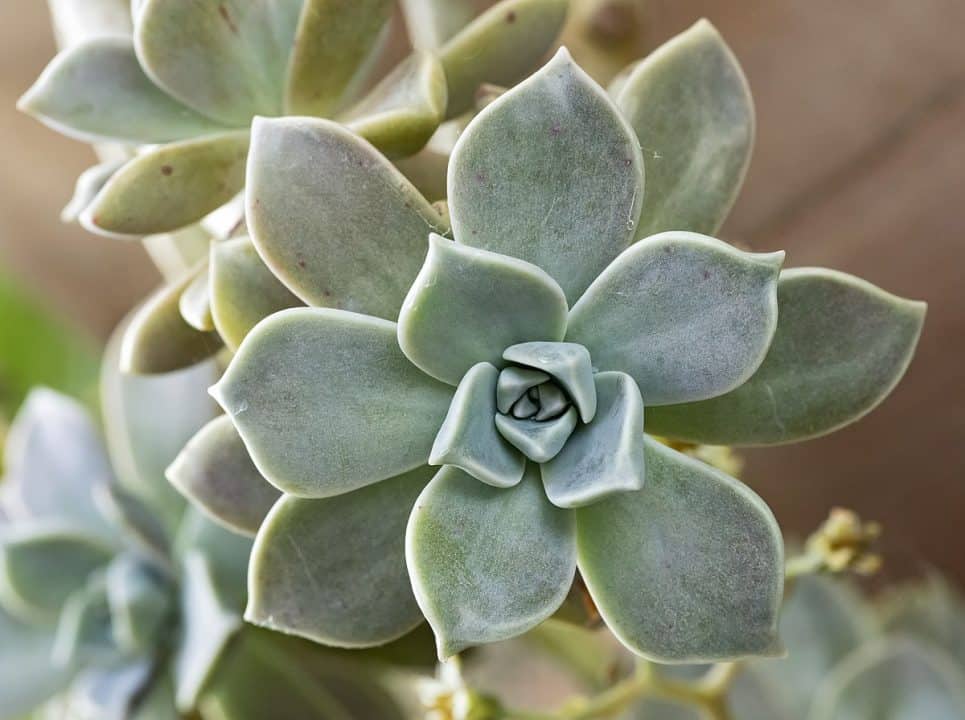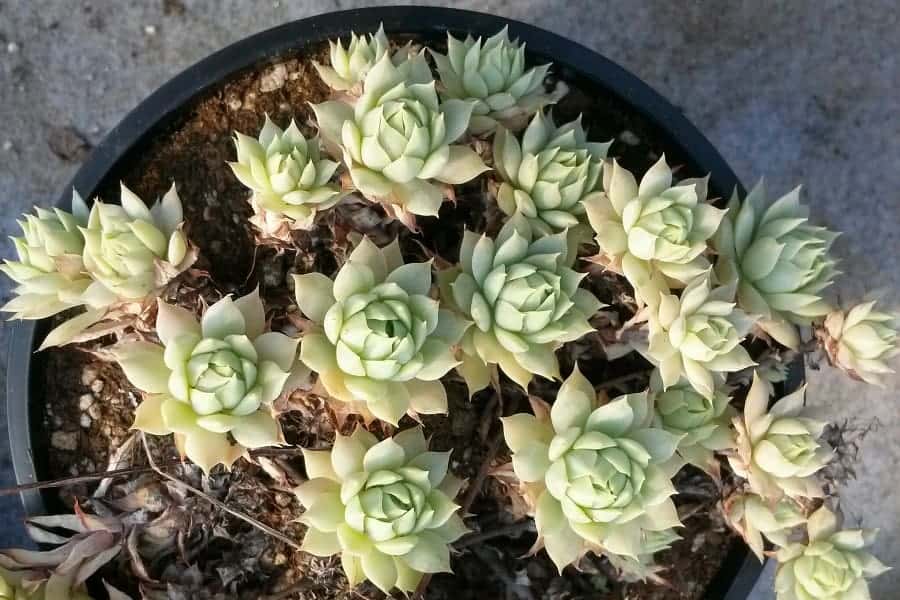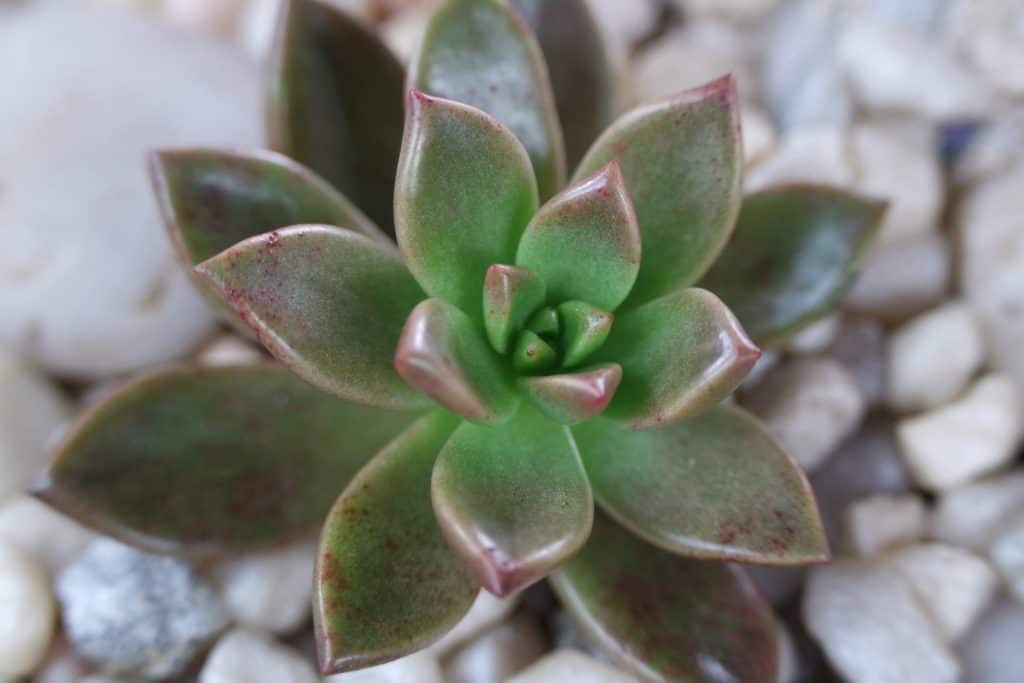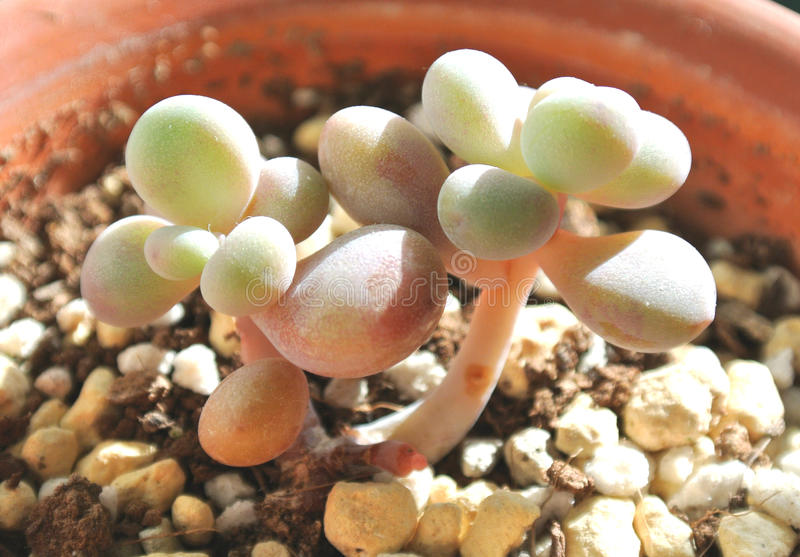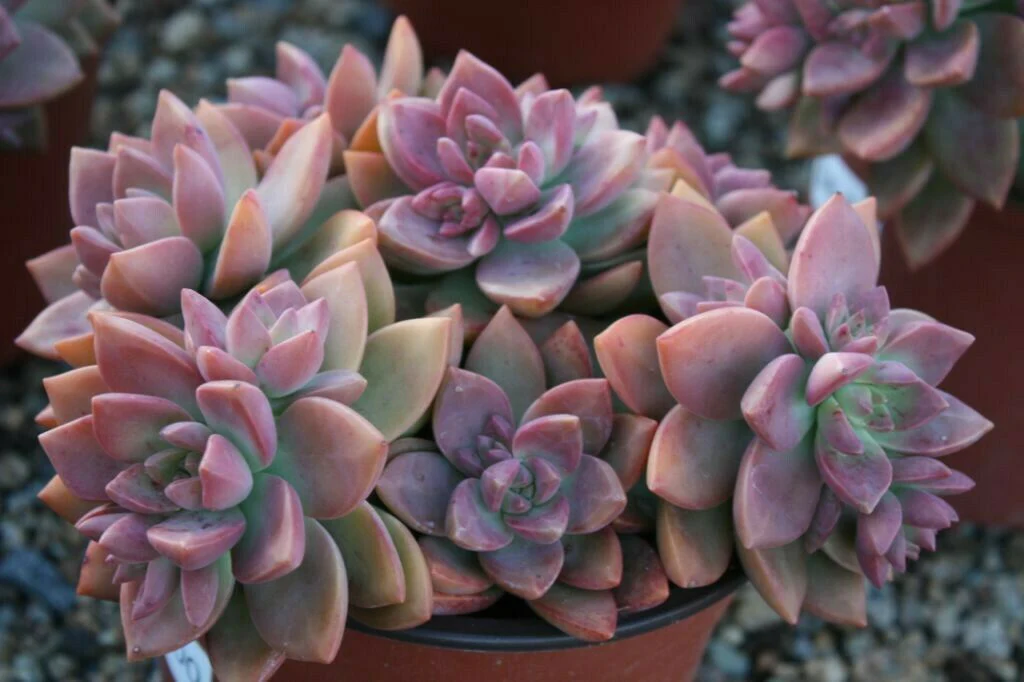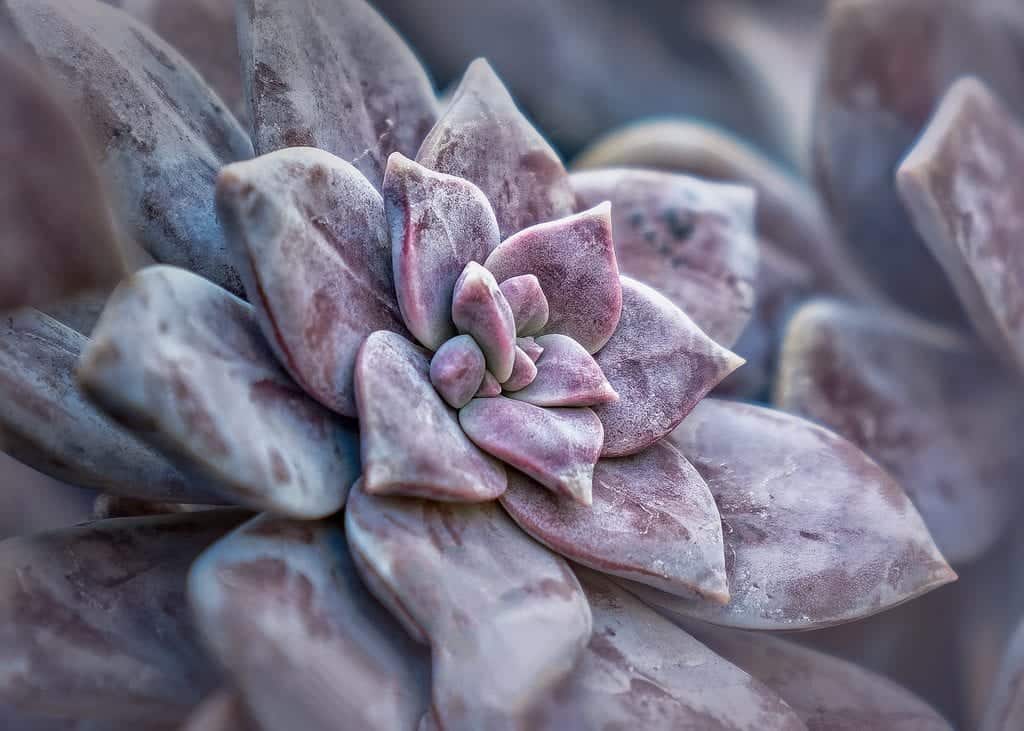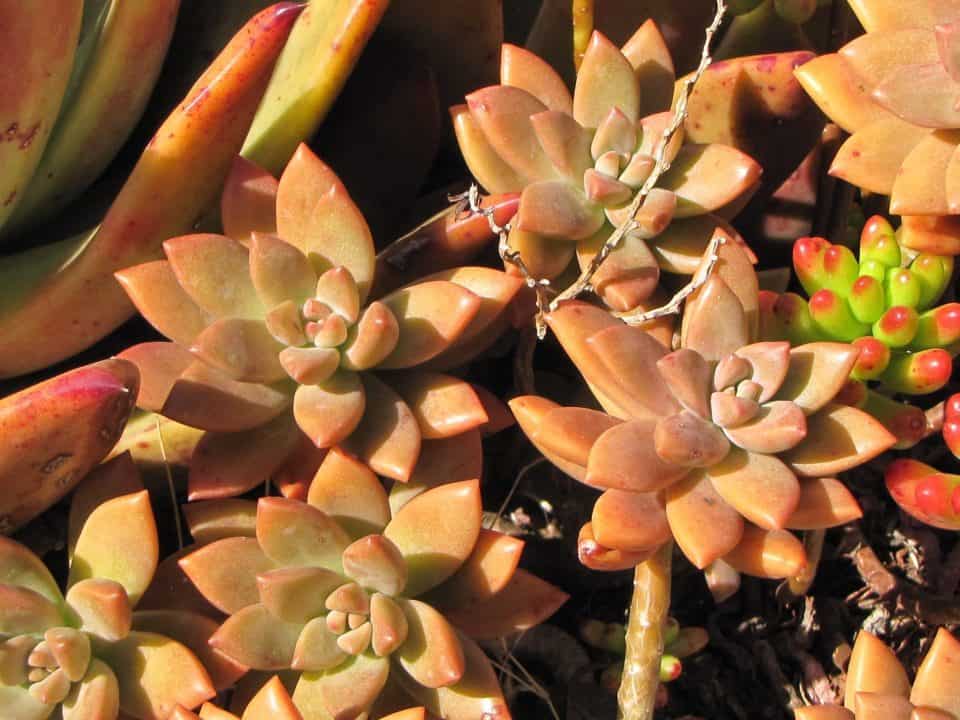Known as the ghost plant succulent, Graptopetalum paraguayense, may be one of the weirdest-looking houseplants you’ll ever encounter. The ghost plant isn’t your typical cactus or succulent, with fleshy leaves and stems you might expect to see on any other plant in your home (no matter how weird they look).
Instead, graptopetalum paraguayense ghost plant features tall stalks that extend upward from the soil like alien antennae, topped with clusters of whitish flowers that are often described as ghostly in appearance.
I’ve recently started to experiment with ghost plants (Graptopetalum paraguayense), and I’m delighted with how easy they are to care for. Ghost plants also have beautiful, variegated foliage that gives the plant great ornamental value.
This plant grows best in areas where temperatures stay between 70 and 85 degrees Fahrenheit (21-29 degrees Celsius). It makes a great houseplant because it can tolerate the lower light levels you find indoors, and it doesn’t need regular watering.
This ghost plant succulent with white-colored flowers, Graptopetalum paraguayense will add interest to any succulent collection with its unusual name and equally unusual appearance.
Named after its ghostly white petals and its native country of Paraguay, this striking plant is not shy about attracting attention, but remains fairly undemanding when it comes to caring requirements, making it ideal for succulent collectors who want to experience the wonder of the ghost plant without much fuss.
Origin and distribution
Graptopetalum paraguayense is native to Mexico, where it grows in lower-elevation deserts and hills. It also grows in Guatemala, El Salvador, Honduras, Nicaragua and Costa Rica. Ghost plant is not found north of Chihuahua, but it does grow as far south as Buenos Aires in Argentina.
These succulents are common in Arizona and New Mexico. Ghost plants thrive in U.S. Department of Agriculture hardiness zones 9 through 11. In cooler climates, they’re grown indoors as houseplants or outdoors during warm months only. They can be propagated by stem cuttings or seeds.
Graptopetalum paraguayense propagation
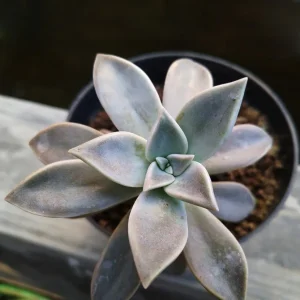
Graptopetalum paraguayense can be propagated through stem cutting. Wait for a few weeks after taking a cutting, and then bury it in loose soil or sand with only 1 to 2 inches showing above ground.
The stems of Ghost Plants do not root easily and are particularly slow-growing. Be patient, as propagation may take years—however, they will grow roots when conditions are right.
After rooting, plant your new Graptopetalum paraguayense in well-draining soil that’s high in organic matter.
These plants can be propagated by division as well; however, note that older plants are more difficult to divide successfully than younger ones. For optimal results, water newly planted ghost plants thoroughly until water drains freely from their holes.
Fertilize lightly using an all-purpose fertilizer such as 10-10-10 every two months during the spring and summer growing seasons. In fall and winter, use a balanced fertilizer such as 12-12-12 at half strength once per month. Do not over-fertilize these plants, as too much nitrogen can cause them to develop soft spots on their leaves.
Although you don’t need to worry about pruning these succulents, if you choose to do so, wait until late spring or early summer. Prune back dead or damaged portions of each stem just beyond where live tissue begins. You can also trim off any extra-long stems if desired.
Graptopetalum paraguayense care information
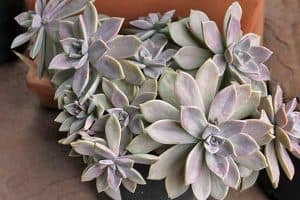
The graptopetalum paraguayense originates from Mexico, but is considered native to Argentina. This means it can survive in a wide range of environments. In fact, it thrives in areas with low amounts of rainfall, with temperatures ranging from 40 to 70 degrees Fahrenheit, and full sunlight or partial shade.
Do not let your graptopetalum paraguayense dry out completely, however; make sure to give them a nice soak once every few weeks or so. If you are growing them indoors, keep an eye on their soil for any signs of rot.
If you notice anything strange about their leaves, such as black spots or moldy patches, remove those leaves immediately. To propagate your ghost plant, simply place some cuttings in water until they root—and voila! You have new plants!
Light requirement
Try to provide your Graptopetalum paraguayense with as much light as possible, but do not expose it to direct sunlight all day. Instead, place it in an area where indirect sunlight falls on it from a nearby window.
Ghost plants like low humidity and will benefit from a weekly misting of their soil and leaves. Repotting is recommended only when necessary, as frequent potting can cause root rot.
Soil/potting mix
When planting a ghost plant, it’s best to use soil with excellent drainage, as they do not enjoy sitting in wet soil.
A peat-based mix is optimal for these plants, though you can use any potting mix that allows water to drain quickly. You don’t want your plant sitting in soggy soil—it will cause root rot and kill your new ghost plant.
Watering
Graptopetalum paraguayense is very sensitive to overwatering, so keep an eye on how much water you give them. They should be watered when their soil has dried out completely. Ghost plants like their roots exposed to air; make sure there are no rocks or other objects covering them up.
It’s best to water ghost plants only when their soil is completely dry. But, make sure not to give them too much water at once!
It is best to let the water run through their soil and then remove any excess before putting back in its pot. It is also very important to allow their soil to drain after watering, so be sure they are on a tray or saucer with adequate holes.
Fertilizer
Graptopetalum paraguayense succulents, like other plants, require regular feeding with fertilizer. During active growth, a complete fertilizer such as 10-10-10 is recommended.
This type of fertilizer will encourage healthy foliage and blossoms while preventing deficiencies in macronutrients such as nitrogen, phosphorus, and potassium. In late summer or fall, switch to a controlled-release 15-30-15 formula to provide for continued growth through the winter months.
Temperature
The ghost plant requires a temperature of about 70 to 80 degrees. The ideal time for watering is in late fall and early spring.
It can be placed outdoors during these seasons. If you are placing it outdoors, then water it once every three or four weeks in order to keep its soil moist, but never soggy. You should place it in bright sunlight or near a window with full sun exposure.
Humidity
Most succulents come from desert-like conditions. This means they can be quite sensitive to humidity changes, especially during winter months when indoor heaters are turned on full blast.
During the winter months, it’s important to reduce your home’s humidity as much as possible to avoid rot and damage to your succulents and cacti. An easy way to reduce your home’s humidity is by reducing your use of hot water.
The ideal humidity range is 40-50% RH. The easiest way to achieve a low humidity level in your home is by using a dehumidifier. You can also reduce your home’s humidity by opening windows and using exhaust fans when cooking or taking showers.
Pruning
The graptopetalum paraguayense requires little to no pruning. It is an excellent plant for beginners who are interested in succulents and cacti. The Ghost Plant grows naturally like a bush but can be pruned into any desired shape and size for you to place in your office or home.
You can also grow them vertically by placing them on a trellis. If you want to keep your ghost plant small and compact, just pinch off any new shoots that emerge from its base.
When to repot
Repot your ghost plant after it’s been in its current pot for about a year, or if you notice that its roots are growing out of its drainage holes.
Over-potting is a common cause of health problems for succulents; make sure you don’t give your ghost plant too much space. When repotting, move it into a pot one size larger than before, and remove all but 1/3 of its soil mix.
Add fresh, fast-draining cactus soil to fill any empty spaces between its roots. Water thoroughly until water drains from the bottom of your pot. Place your plant where it will receive bright light, but not direct sunlight—too much sun can burn your plant’s leaves!
Graptopetalum paraguayense does best at temperatures between 60 and 80 degrees Fahrenheit. You can place them outside during the summer months, as long as they have access to plenty of water and shade during hot days.
Dormancy
All plants go dormant at one point or another. This is simply a period of reduced growth or complete inactivity that often occurs in response to environmental conditions such as changes in temperature, water availability, and even light.
There are many reasons why your graptopetalum paraguayense ghost plant may be struggling to recover—but typically, it’s because it hasn’t been exposed to enough sunlight.
Graptopetalum paraguayense love bright light! If you notice yours beginning to droop, try moving it into a sunnier spot for a few hours each day until its leaves perk up again. If you can find an east-facing window with indirect sunlight, all the better!
Flowers & Fragrance
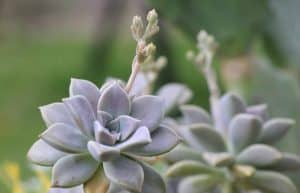
One of the most delightful features of graptopetalum paraguayense is its flowers and fragrance. Large, white, star-shaped flowers that are extremely fragrant bloom in profusion during spring and summer.
This makes this plant one of those rare succulents that you can enjoy as a potted houseplant and also take outdoors to grace your garden beds with a cloud of scented white blooms when warm weather arrives.
Growth rate
Graptopetalum paraguayense plants are slow-growing. With proper care, it can take up to three years for a ghost plant to develop its characteristic rosette of leaves. It often takes one or two years just for it to flower and bear fruit!
Ghost plants are drought tolerant, but they tend to lose their leaves when stressed by a lack of water. As such, don’t be too quick to re-pot them or they might go into shock.
Toxicity
Graptopetalum paraguayense leaves, stems, and roots are generally not considered toxic to humans. However, some people may be sensitive to any plant material and exhibit an allergic reaction or skin irritation upon exposure.
If you have a known allergy or sensitivity to plants or their compounds, be sure to avoid handling these succulents. It’s also wise to make sure that children and pets do not ingest Graptopetalum plants.
USDA Hardiness Zones
Graptopetalum paraguayense grows best in USDA hardiness zones 8-10. In colder climates, it can be grown as a houseplant or brought outside during warm summer months.
Pests and diseases
Graptopetalum paraguayense is susceptible to spider mites and can get a foliar fungus disease called blackspot. To prevent an infestation of pests and diseases, only buy reputable plants that are pest-free and disease-free.
Make sure you quarantine new plants by putting them in a different room away from your established plant for at least two weeks to make sure they don’t bring anything along with them. If you see any signs of pests or disease on your ghost plant, treat it immediately. If left untreated, these problems will eventually kill off your entire ghost plant collection.
Conclusion
Ghost plant, or Graptopetalum paraguayense, is a succulent that can be propagated easily from cuttings. It’s one of many succulents with cute and cuddly names in the Crassulaceae family. Ghost plant is quite unique in their appearance.
The flowers are white, pink, yellow, or purple sometimes. If you have a sunny spot in your home where you want to add some color to your décor while also adding something unusual and interesting to look at, graptopetalum paraguayense might be just what you need!
